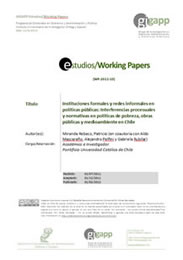Challenges of the Unemployment Protection System and Active Policies in Spain
Abstract
A brief overview of the history of the Spanish Unemployment Protection System (UPS) from the reestablishment of democracy in 1978 shows the challenges that it has faced over the years. Some of the most persistent problems of the UPS that have not been solved by the successive reforms are high unemployment, the sustainability of the public spending system, the insufficient protection of the unemployed people or people with low quality jobs and the inefficacy to put back the unemployed in the job market. In this paper we describe the main characteristics and challenges of the UPS in Spain and we discuss some potential reforms that could be implemented to make the system more effective from different points of view. In the next section, the main reforms of the UPS from the reestablishment of the democracy until now will be described in order to analyse which have been the main challenges of the system and to what extent they have been overcome. After this, the current unemployment protection system will be analysed. In the fourth section, we will introduce the main challenges and diagnosis of the current system. And, finally, we will explain some conclusions including the reforms proposed by the different actors involved.
Downloads
References
Arcanjo, M. (2011) “Unemployment Insurance Reform 1991-2006: A new Balance between Rights and Obligations in France, Germany, Portugal and Spain”, Social Policy & Administration, 46, 1:1-20.
Arranz, JM., C. García-Serrano y V. Hernanz (2013): “Active labor market policies in Spain: a macroeconomic evaluation”, International Labor Review, 152 (2), 327-348.
Berstelsmann Stiftung (2014) “2014 Labor Markets Report. Labor Market Policy” Sustanaible Governance Indictors.
Bonoli, G. (2011) “Active Labor Market Polity in a changing Economic Context” en J. Clasen y D. Clegg (eds.) Regulating the Risk of Unemployment National Adaptations to Post-Industrial Labor Markets in Europe. Oxford: Oxford University Press. 318-332.
CES (2011) “Memoria sobre la situación socioeconómica y laboral de España 2011” Consejo Económico y Social España.
CES (2012) “Memoria sobre la situación socioeconómica y laboral de España 2012” Consejo Económico y Social España.
CCOO (May 2014) “CCOO y UGT piden políticas específicas para los parados de larga duración, jóvenes, inmigrantes y mujeres” http://goo.gl/RKcRAQ
CCOO (2014) “La Garantía Juvenil es insuficiente para afrontar la gravísima situación de desempleo en la que se encuentran los jóvenes” Available at http://goo.gl/vNPd6u
Clasen, J. and D. Clegg (eds.) (2011) Regulating the Risk of Unemployment National Adaptations to Post-Industrial Labor Markets in Europe. Oxford: Oxford University Press.
Comisión Europea (2012) “Long term Unemployment 2012”.
De la Rica, Sara y Anghel, Brindusa (2014) “Los parados de larga duración en España en la crisis actual”, Documento de Trabajo, 185. Madrid: Fundación Alternativas.
Del Pino, E. y Ramos, J.A. (2013) “Políticas de Protección por Desempleo en perspectiva comparada: hacia la re-mercantilización y la activación“, en E. del Pino y Mª J. Rubio (eds.) Los Estados de Bienestar en la encrucijada: políticas sociales en perspectiva comparada. Madrid. Tecnos. 212-236.
García- Serrano, C., JM. Arranz, O. Cantó y A. Malo (2012)El sistema español de protección y la duración efectiva de los episodios de paro, Premio FIPROS 2011/02, Dirección General de Ordenación de la Seguridad Social, Ministerio de Empleo y Seguridad Social.
Dolado, J.J et al. (2013a) “Youth Labor Market Performance in Spain and its determinants: A Micro-Level perspective”, OECD Economics Department Working Papers, No 1039 http://goo.gl/2AEBqb
Dolado, Juan J.; Felgueroso, Florentino and Jancen, Marcel (2013b) “Spanish youth unemployment: a dejà vu” . Paper prepared for the ENEPRI/CEPS conference on “Youth unemployment after the great recession: evidence and lessons of national policies” in Brussels
El País (February 2013) La CEOE quiere un contrato único y ‘miniempleos’ para los jóvenes http://goo.gl/pafbSC
European Commission (2014) “Youth unemployment rate. Europe 2020 Report” http://goo.gl/aX3rdL
Jimeno, Juan F. and Rodriguez-Palenzuela (2002) “Youth unemployment in the OECD: demographic shifts, labor market institutions, and macroeconomic shocks”. European Central Bank. Working Paper No.155. http://goo.gl/fvVY7W
Lopez, Isidro y Emanuel Rodriguez (2011) “The Spanish Model”, New Left, 69, 5-28.
Mato, F. J. (2011) “Spain: fragmented unemployment protection in a segmented labor market” en Jochen Clasen y Daniel Clegg (eds.) Regulating the Risk of Unemployment National Adaptations to Post-Industrial Labor Markets in Europe. Oxford: Oxford University Press. 164-186.
Molina, José Alberto and Barbero, Enrique (2005) “El Desempleo Juvenil en Europa y España” Acciones e Investigaciones Sociales, pp. 137-155
Negueruela, E. (2013) Prestaciones Justas para tiempos de crisis. Estudios, 68. Madrid: Fundación 1º de Mayo.
Nagore García, Amparo, José E. Devesa Carpio, Inmaculada Domínguez Fabián (2012), La Sostenibilidad y equidad financiera del sistema de protección Por desempleo. El caso español,
Tanveer Choudhry, Misbah; Marelli, Enrico and Signorelli, Marcello (2010) “Youth Unemployment and the Impact of Financial Crisis”. Paper presented at the XXV Convegno Nazionale di Economia del Lavoro. Università degli Studi G.D’Annunzio, Chieti-Pescara
Rocha, Fernando y Enrique Negeruela (2014) El mercado de trabajo en España en 2013, ¿Hacia una recuperación frágil y socialmente injusta de la crisis?
Toharia, Luis, J.M. Arranz, C. García Serrano y V. Herranz (2009) El sistema español de protección por desempleo: equidad, eficiencia y perspectivas, Estudio FIPROS 2008/26, Dirección General de Ordenación de la Seguridad Social, Ministerio de Trabajo e Inmigración.
Van Vliet, Olaf, Caminada, Koen and Goudswaard, K. (2012) “The Political economy of Labor Market Policies in Western and Eastern European Countries”, NeuJob Working Paper D6.3. http://media.leidenuniv.nl/legacy/ovv-2012-06.pdf
Copyright (c) 2017 Eloísa del Pino, Angie Gago

This work is licensed under a Creative Commons Attribution-NonCommercial-ShareAlike 4.0 International License.
Those authors who have publications with this journal, accept the following terms:
a. Authors will retain their copyrights and guarantee the journal the right of first publication of their work, which will be simultaneously subject to the Creative Commons Attribution-NonCommercial-ShareAlike 4.0 International (CC BY-NC-SA Recognition License). 4.0) that allows third parties to share the work as long as its author and its first publication are indicated in this journal.
Under this open access license, readers (users) can:
- Share — copy and redistribute the material in any medium or format
- Adapt — remix, transform, and build upon the material
Under the following terms:
-
Attribution — Users must give appropriate credit, provide a link to the license, and indicate if changes were made. You may do so in any reasonable manner, but not in any way that suggests the licensor endorses you or your use.
-
NonCommercial — Users may not use the material for commercial purposes.
-
ShareAlike — If remix, transform, or build upon the material, users must distribute your contributions under the same license as the original.
- No additional restrictions — Users may not apply legal terms or technological measures that legally restrict others from doing anything the license permits.
b. Authors may adopt other non-exclusive license agreements for the distribution of the version of the published work (eg: deposit it in an institutional telematic archive or publish it in a monographic volume) provided that the initial publication in this journal is indicated.
c. Authors are allowed and recommended to disseminate their work through the Internet (e.g. in institutional telematic files or on their website) before and during the submission process, which can lead to interesting exchanges and increase citations of the published work. (See The effects of open access).



